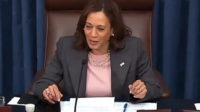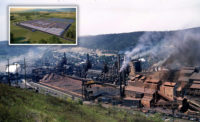The Biden administration announced a multi-pronged effort on Jan. 12 to stimulate clean energy construction in the U.S., including the formal launch in February of the administration's first offshore wind lease auction—the largest done at one time in the U.S.
The new push also includes other changes to ease permitting, build renewables projects on public lands and modernize the nation's aging electrical grid.
Federal officials said the actions would accelerate U.S. market efforts to meet President Joe Biden's goals to deploy 30 GW of clean energy by 2030, issue permits for 25 GW of new solar, wind and thermal projects on public lands by 2025 and reduce carbon emissions from electricity to zero by 2035.
The U.S. Interior Dept. said it will conduct an auction on Feb. 23 for six leases covering 480,000 acres in the New York Bight, south of New York City and Long Island and along the New Jersey coast, which it said could result in at least 5.6 to 7 GW of offshore wind energy capacity.
As part of the goal to create clean energy sector jobs and a bigger U.S. supply chain while also insuring better interaction with other ocean users and benefit to underserved communities, auction rules will require use of project labor agreements to build offshore wind projects, and workforce development..
The rules also will include incentives for use of U.S.-made major project components, including turbine blades and foundations.
"Apprenticeship training programs are ready to capitalize on these initiatives and provide new careers for a generation of workers who want and deserve to be part of the middle class,” said Matthew Aracich, president of the Building and Construction Trades Council of Nassau and Suffolk Counties on Long Island. “The impact of [the] actions coupled with developing the region’s offshore wind market will certainly change our environment and economy for the better.”
Developers signing leases also must identify communities and marine users that could be affected by offshore wind projects, and must show evidence they are engaging with them. The government has reduced by 72% the lease area that was originally outlined last year for auction following environmental review and stakeholder input.
Click here for more auction details, including the list of qualified bidders. Interior's Bureau of Ocean Energy Management will require separate developers for the six lease areas to spur energy price competition, said director Amanda Lefton.
The bureau also announced actions to progress project development in other U.S. waters, including release of a draft environmental review of proposed leases in the 206-sq-mile Humboldt Wind Energy Area in northern California that, if developed, could generate up to 1.6 GW of energy, and start of s similar assessment for potential leases in Gulf of Mexico federal waters.
DOE Juices the Grid
The U.S. Dept. of Energy also released its plan to modernize transmission infrastructure across the country, using $20 billion in federal financing tools, many of which were created or expanded under the new Infrastructure Investment and Jobs Act, signed into law in November.
The effort includes the new $2.5-billion Transmission Facilitation program, a $3-billion expansion of the Smart Grid Investment Grant program, and more than $10 billion in grants for states, tribes and utilities to enhance grid resilience and prevent power outages.
DOE also intends to use existing programs, including the $3-billion Western Area Power Administration Transmission Infrastructure program, and a number of loan guarantee programs through the Loan Program office to fund transmission line upgrades.
Administration officials say the actions are needed to fix the aging U.S. network of electrical transmission systems. According to DOE, these systems need to be expanded by 60% by 2030, and may need to be tripled by 2050.
More than 70% of the nation’s grid transmission lines and power transformers are more than 25 years old.
DOE’s drive to modernize the grid will create jobs “and reliably move clean energy to where it’s needed most,” said Energy Secretary Jennifer Granholm in a statement.
The Interior, Agriculture, Defense and Energy departments, along with the U.S. Environmental Protection Agency, announced a new memorandum of understanding to improve agency coordination and streamline reviews for renewable energy projects on public lands.
A senior administration official said during a Jan. 11 press call that the memorandum is focused on interagency cooperation, and does not make change the project environmental review process under the National Environmental Policy Act (NEPA)..







Post a comment to this article
Report Abusive Comment